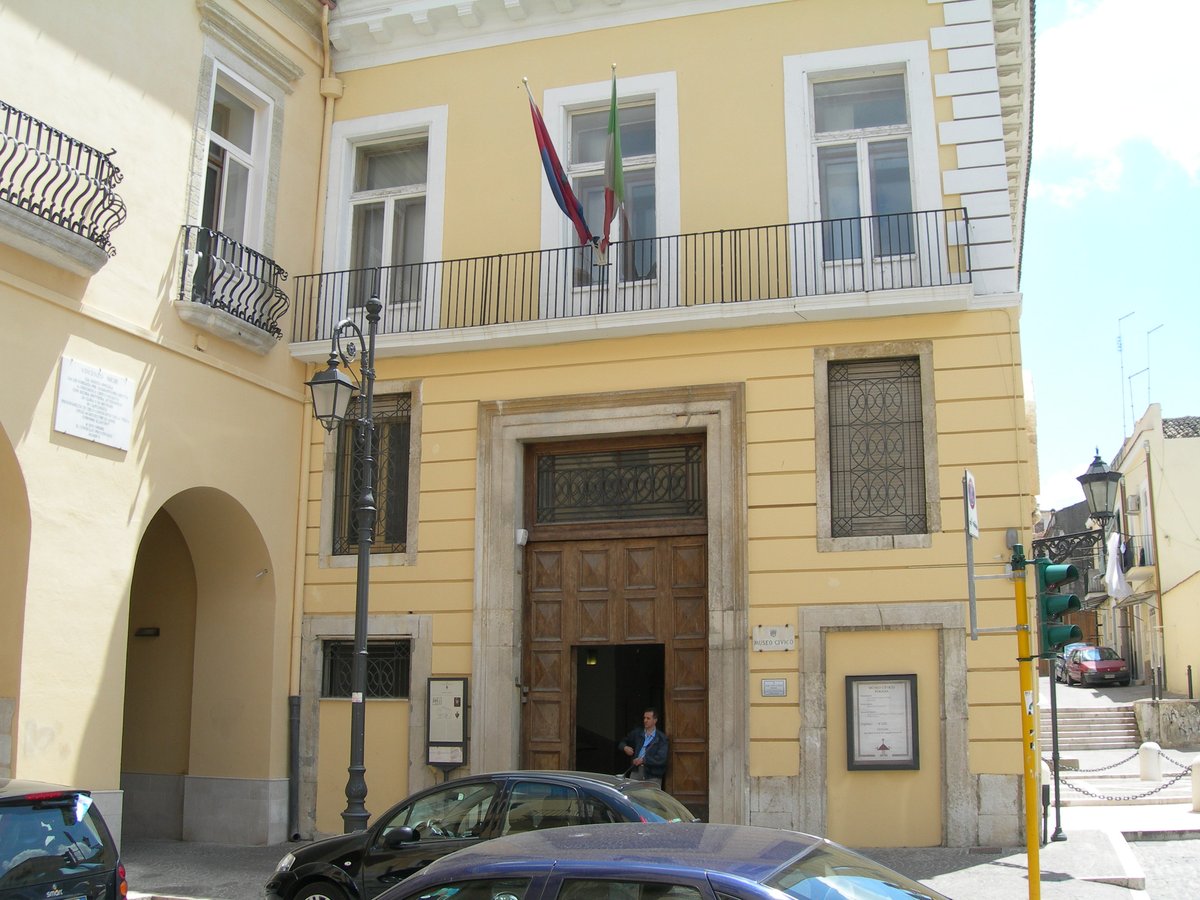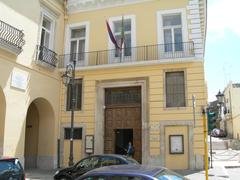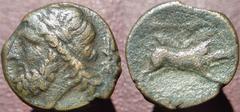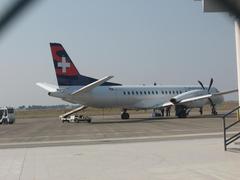
Civic Museum of Foggia: Visiting Hours, Tickets, and Travel Guide
Date: 14/06/2025
Introduction
Nestled in the heart of Foggia, Italy, the Civic Museum of Foggia (Museo Civico di Foggia) stands as a vibrant guardian of the region’s archaeological, historical, artistic, and ethnographic heritage. Established in the early 20th century, the museum is a testament to the city’s dedication to preserving its layered cultural identity—shaped by millennia of civilizations, from prehistoric settlers and Romans to medieval and Renaissance influences. Housed in a historic building that blends Neoclassical and late Baroque elements, the museum offers visitors not only a journey through time but also an immersive architectural experience.
Strategically located within walking distance of Foggia’s major historical landmarks—including the Cathedral of Foggia and the UNESCO-recognized Palazzo Dogana—the Civic Museum serves as a central cultural hub for locals and travelers alike. Its thoughtfully designed galleries, modern amenities, and accessibility features ensure a welcoming environment for diverse audiences. The museum also enriches its offerings with guided tours, educational programs, and special events, making it an essential stop for anyone eager to explore the history and culture of Apulia.
For the latest information on visiting hours, ticketing, and special exhibitions, consult the official museum website, visit.puglia.it, and thegoguy.com.
Table of Contents
- Historical Background and Architectural Significance
- Visiting Information
- Museum Collections and Highlights
- Visitor Experience and Tips
- Nearby Attractions
- Frequently Asked Questions (FAQ)
- Plan Your Visit & Call to Action
- Sources
Historical Background and Architectural Significance
Origins and Development
The Civic Museum of Foggia was founded in the early 20th century, part of a broader Italian movement to institutionalize local heritage and define national identity after unification. Located on the fertile Tavoliere delle Puglie plain, Foggia has long been a crossroads for Romans, Byzantines, Normans, Swabians, and Aragonese—each leaving their mark on the city’s urban fabric and traditions (thegoguy.com). The museum’s collections reflect this layered history, tracing Foggia’s evolution from prehistoric settlements through the Roman era, the Middle Ages, and into the Renaissance and modern periods.
Collection Highlights
Archaeological finds—including ceramics, tools, funerary objects, and Roman-era sculptures—offer insights into daily life and beliefs of Foggia’s ancient inhabitants. The museum’s medieval and Renaissance sections feature religious artworks, illuminated manuscripts, and items illustrating the city’s commercial and ecclesiastical power. This curatorial approach provides visitors with a chronological exploration of the region’s past, supporting the museum’s educational mission (thegoguy.com).
The Museum Building and Urban Context
The Civic Museum is housed in a historic structure inspired by Neoclassical and late Baroque styles, with symmetrical facades, decorative pilasters, and arched windows. Its central courtyard invites natural light and offers a tranquil visitor space. The museum’s location in Foggia’s historic center, near the Cathedral and Palazzo Dogana, situates it among a cluster of prominent civic landmarks (thegoguy.com). Adaptive reuse of the building preserves Foggia’s architectural heritage while revitalizing the city’s cultural landscape.
Inside, period details have been preserved alongside modern exhibition techniques, such as climate-controlled cases and multimedia installations. Accessibility is prioritized with ramps and elevators, and dedicated spaces host temporary exhibitions and public events.
Visiting Information
Location and Access
- Address: Piazza Vincenzo Nigri 3, 71121 Foggia, Italy
- Getting There: The museum is centrally located, a 10–15 minute walk from Foggia train station and accessible by local buses. Paid parking is available nearby, though spaces may be limited during peak hours.
Visiting Hours
- Regular Hours: Tuesday to Sunday, 9:00 AM–1:00 PM and 4:00 PM–7:00 PM
- Closed: Mondays and select public holidays
- Note: Hours may vary during special events or seasonal changes; always check the official Comune di Foggia website for the latest updates.
Tickets and Admission
- Standard Adult Ticket: €5
- Concessions: Discounts for students, seniors, families; children under 18 typically enter free
- Special Exhibitions: May require an additional fee
- How to Buy: Purchase at the entrance or online via the official website
Facilities and Accessibility
- Accessibility: Step-free entrance, elevator, accessible restrooms; some areas may be less accessible due to the historic layout
- Amenities: Cloakroom, lockers, gift shop with books, postcards, and crafts
- Food and Drink: No on-site café, but numerous eateries are nearby in the city center
Guided Tours and Educational Programs
- Guided Tours: Available in Italian; English tours by prior arrangement
- Audio Guides: Multilingual options for a small fee
- Educational Workshops: For children and school groups, focusing on archaeology, art, and local traditions
- Special Events: Lectures, temporary exhibitions, and cultural programs are announced on the museum’s official page
Museum Collections and Highlights
Archaeological Collections
Discover artifacts spanning from the Neolithic era—such as tools from Passo di Corvo, Europe’s largest Neolithic site—to Roman coins, ceramics, and statuary (visit.puglia.it; museumrun.com). The Daunian Stele, unique funerary stone monuments, showcase intricate pre-Roman artistry (savoringitaly.com). Roman mosaics and everyday objects illuminate Foggia’s historical role as a commercial and cultural hub (triplyzer.com).
Ethnographic and Historical Collections
Exhibits highlight traditional costumes, tools, musical instruments, and household items, narrating Foggia’s rural and urban life from the 18th to 20th centuries (visit.puglia.it). Archival materials, including photographs and manuscripts, document pivotal events such as the 18th-century earthquake and World War II (italianenthusiast.com).
Artistic and Natural History Sections
The museum’s art gallery features regional artists like Pietro and Paolo Cannata, with works ranging from Renaissance to contemporary pieces (thecrazytourist.com). The natural history section presents the flora and fauna of the Gargano Promontory and Apulia, incorporating interactive elements to promote conservation (triplyzer.com).
Visitor Experience and Tips
- Best Time to Visit: Weekday mornings offer a quieter experience; May–September provides pleasant weather for exploring the city (TheBiteTour.com).
- Photography: Non-flash photography is allowed in permanent galleries; check for restrictions in temporary exhibits.
- Accessibility: Museum is wheelchair accessible but some historic areas may pose challenges.
- Language: Most signage is bilingual (Italian/English), but staff may have limited English proficiency.
- Dress Code: Wear comfortable shoes for exploring multiple floors.
- Duration: Visits typically last 1–2 hours, with more time needed for enthusiasts.
Nearby Attractions
Enhance your itinerary by visiting:
- Cathedral of Foggia (Basilica Cattedrale di Foggia): Romanesque-Gothic masterpiece dating to the 12th century.
- Palazzo Dogana: UNESCO site noted for its Baroque and Neoclassical architecture.
- Villa Comunale: Foggia’s public park, ideal for relaxation.
- Church of Saint Mary of Constantinople: Elegant 18th-century Baroque church (thegoguy.com).
- Enjoy local Apulian cuisine at nearby trattorias, and explore Foggia’s vibrant markets.
Frequently Asked Questions (FAQ)
Q: What are the Civic Museum of Foggia’s opening hours?
A: Tuesday to Sunday, 9:00 AM–1:00 PM and 4:00 PM–7:00 PM; closed Mondays and some holidays. Check the official website for updates.
Q: How much do tickets cost?
A: Standard adult admission is around €5, with discounts for students, seniors, and children. Special exhibitions may have extra fees.
Q: Is the museum wheelchair accessible?
A: Yes, with ramps and elevators, though some areas may be less accessible due to the historic structure.
Q: Are guided tours available in English?
A: Yes, by prior arrangement.
Q: Is photography allowed?
A: Non-flash photography is allowed in most permanent galleries; check for restrictions.
Q: How do I get to the museum?
A: It’s centrally located, a short walk from Foggia train station and accessible by bus or car.
Plan Your Visit & Call to Action
The Civic Museum of Foggia offers a comprehensive and engaging gateway into Apulia’s past and present. Plan your visit by checking current hours and ticket information on the official museum website. For an enhanced experience, consider booking a guided tour or participating in an educational workshop.
Download the Audiala app for real-time updates, personalized museum guides, and audio tours. Follow the museum’s social media channels and explore related articles on Foggia’s historical sites to enrich your cultural journey. Make the Civic Museum the centerpiece of your exploration of Foggia’s rich heritage!


